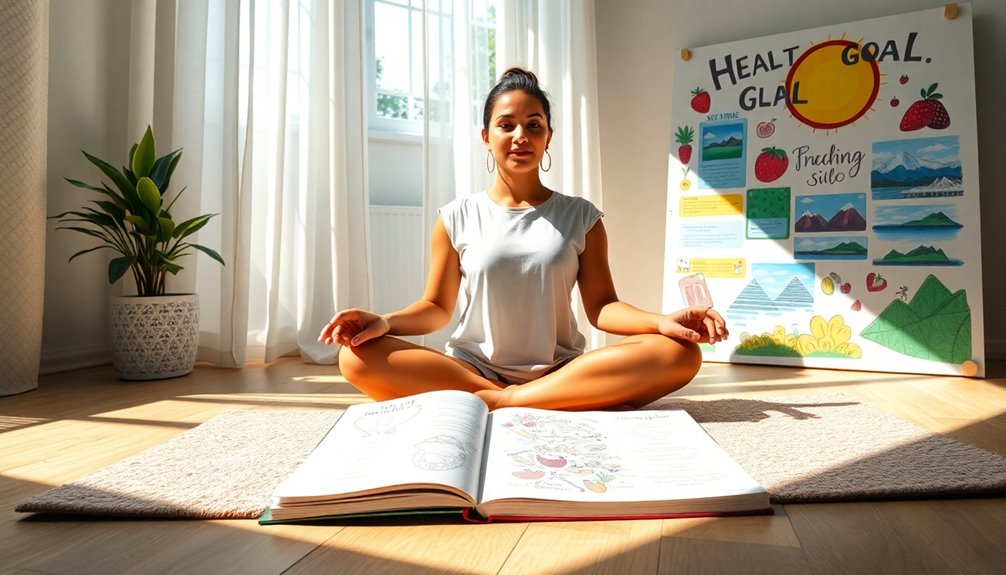Visualization can greatly enhance your journey toward achieving health goals. By creating vivid mental images of your desired outcomes, you boost your motivation and focus. Finding a quiet space to practice helps, as you can incorporate details like sights and feelings that resonate with you. Regular visualization strengthens your commitment and prepares you for challenges. When you share your goals with supportive friends, it fosters a sense of community and encouragement. With dedication and consistency, you can access the full potential of visualization. Discovering more about effective techniques can further support your success and transformation.
Key Takeaways
- Visualization enhances motivation and focus by creating a mental image of your health goals, making them feel more attainable.
- Regular practice of visualization fosters new neural pathways, boosting your motivation and preparing you for challenges ahead.
- Setting clear health goals and visualizing them helps create a roadmap, breaking down objectives into manageable steps for easier achievement.
- Incorporating visualization into your daily routine, alongside affirmations, aligns your mind and body towards your health ambitions.
- Sharing your visualization journey with a supportive community increases commitment and encourages you to celebrate milestones along the way.
Understanding Visualization Techniques

Visualization techniques are essential tools that can help you achieve your health goals. By creating a mental image of your desired outcome, you're not just dreaming; you're actively engaging your mind in the process of change. This practice can boost your motivation, enhance your focus, and even align your physical actions with your goals. Imagine waking up each day feeling empowered, ready to take on challenges, and committed to your well-being.
To get started, consider a few visualization tips.
First, find a quiet space where you can relax and concentrate. Close your eyes and take a few deep breaths to ground yourself. Picture your health goal vividly—whether it's running a marathon, losing weight, or simply feeling more energetic. The more details you incorporate, such as sights, sounds, and feelings, the more real it will become for you.
Another vital tip is to practice regularly. Consistency is key; the more you visualize, the more your brain will adapt to the changes you want to make. Share your journey with supportive friends or a community, as belonging can amplify your commitment to your health goals.
The Science Behind Visualization

Harnessing the power of your mind can dramatically influence your ability to reach health goals. When you visualize your success, you're not just daydreaming; you're engaging in a profound cognitive process that activates your brain in ways that can lead to real-world changes. Studies show that visualization can trigger neurological benefits akin to actually performing the activity. This means your brain responds to imagined experiences similarly to how it responds to real ones.
When you visualize yourself achieving your health goals, your brain creates new neural pathways that enhance motivation and discipline. It's like training your mind to believe in your potential, which can resonate deeply within your subconscious. This mental rehearsal prepares you for the challenges ahead, making you more resilient and focused.
Moreover, visualization fosters a sense of community. By sharing your vision with supportive friends or a group, you create an environment where everyone encourages each other. This shared journey not only strengthens your resolve but also enhances the positive effects of visualization. Additionally, incorporating techniques like brainwave entrainment can further enhance your visualization practice by optimizing your mental state for maximum effectiveness.
You're not alone in this; you belong to a collective effort towards better health.
Setting Clear Health Goals

Setting clear health goals is essential for focusing your motivation and concentration effectively. When you establish specific targets, you create a roadmap that guides your journey toward better health. It's not just about desiring to feel better or lose weight; it's about defining what those changes look like for you. Start with goal setting by identifying what's most important in your life—whether it's boosting your energy, improving your diet, or enhancing your fitness levels.
Once you've identified your goals, it's time for action planning. Break down your larger objectives into smaller, manageable steps. For example, if your goal is to run a 5K, start by mapping out a weekly training schedule. Include rest days and gradually increase your running distance. This not only makes your goals feel more attainable but also helps you track your progress along the way.
Remember, you're not alone in this journey. Share your goals with friends or a supportive community. They can provide encouragement and accountability, making your experience even more fulfilling. Celebrate your milestones, no matter how small, as these achievements strengthen your determination. The Adaptive Body Boost program offers positive results that can further support your health journey.
As you commit to this process, keep in mind that setting clear health goals and creating actionable plans aren't just beneficial—they're transformative. You have the power to reclaim your health, and it all starts with taking that initial step. Let's venture on this journey together!
Incorporating Visualization Into Daily Routine

Once you've established your health goals and created a plan to achieve them, incorporating visualization into your daily routine can further enhance your journey. Think of visualization as a powerful tool that aligns your mind and body towards your aspirations. It's more than just daydreaming; it's about creating a mental image of success that can motivate and guide you.
Start by dedicating a few minutes each day to visualization exercises. Find a quiet space where you can sit comfortably. Close your eyes and imagine yourself achieving your health goals. Visualize every detail—what you look like, how you feel, and the positive impact on your life. This mental imagery reinforces your commitment and builds confidence.
Pair your visualization practice with daily affirmations. Speak kindly to yourself and affirm your commitment to your health goals. Phrases like "I am capable of achieving my goals" or "I'm becoming healthier every day" can notably shift your mindset. Make these affirmations a part of your morning routine or whenever you need a boost.
It's essential to remember that consistency is key. Incorporate these visualization exercises and affirmations into your daily life, and soon, you'll find that your mind and body start to align with your goals. You're not alone on this journey; many share similar aspirations. Hold onto that sense of belonging and support as you visualize your success and affirm your commitment to a healthier you.
Success Stories and Case Studies

Many individuals have transformed their lives through the power of visualization, showcasing its effectiveness in achieving health goals. Take Sarah, for instance. After struggling with her weight for years, she turned to visualization techniques. Each morning, she pictured herself fit and healthy, feeling the excitement of wearing clothes she loved. The visualization benefits didn't stop at motivation; they led her to make healthier choices, resulting in a significant weight loss of over 30 pounds.
Then there's Mark, who faced chronic anxiety that affected his daily life. By incorporating visualization into his routine, he envisioned calm, peaceful situations, which dramatically changed his mindset. The visualization impact was profound; he found himself handling stressful situations with newfound confidence and ease.
These stories reflect a trend where people like you, looking for support and belonging, find strength in visualization. It's not just about wishing for change; it's about creating a mental image that propels you forward.
When you visualize your goals, you tap into a reservoir of motivation and resilience. Whether it's weight loss, stress reduction, or improved fitness, the practice helps you align your actions with your aspirations. Additionally, studies show that mindfulness meditation can enhance the effects of visualization by improving focus and reducing stress.
Frequently Asked Questions
Can Visualization Be Used for Mental Health Improvement?
Absolutely, visualization can be a powerful tool for improving mental health. By picturing scenarios that promote emotional healing, you can create a safe space in your mind. This process helps you reduce stress, allowing you to cope better with life's challenges.
When you visualize positive outcomes, you cultivate hope and resilience. You're not alone in this journey; many find solace in these techniques, fostering a sense of belonging and community.
How Long Does It Take to See Results From Visualization?
Imagine planting a seed; it doesn't bloom overnight. Your visualization timeline varies based on your dedication and consistency.
Some folks notice immediate impact after just a few sessions, while others may take weeks to witness significant changes. Stick with it, and you'll cultivate a garden of resilience and clarity.
Are There Specific Visualization Exercises for Weight Loss?
Yes, there are specific visualization exercises for weight loss that can be really effective! Start by visualizing yourself engaging in mindful eating—imagine savoring each bite and feeling satisfied. Pair this with positive affirmations, like "I'm making healthy choices," to reinforce your commitment.
Picture your ideal body and how it feels to be active and healthy. This combination can motivate you and create a sense of belonging in your wellness journey. You've got this!
Can Visualization Be Combined With Other Wellness Practices?
Absolutely, you can combine visualization with practices like yoga and meditation to enhance your wellness journey. As you flow through poses, visualize your goals and breathe deeply. Incorporating mindfulness and affirmations can further reinforce your intentions, creating a powerful synergy. By merging these techniques, you'll cultivate a deeper sense of belonging and connection to yourself, making your wellness path feel more fulfilling and achievable.
You're not alone in this journey; embrace it fully!
What if I Struggle to Visualize Clearly?
If you struggle to visualize clearly, you're not alone. Start with simple visualization techniques like focusing on specific details or using guided imagery. Breaking it down makes it easier and less overwhelming, helping you overcome obstacles.
Practice consistently, and give yourself grace; improvement takes time. Surround yourself with supportive people who understand your journey, and remember that everyone's visualization process is unique.
You've got this—keep pushing forward!
Conclusion
As you set off on your health journey, think of visualization as your compass, guiding you toward your goals. By harnessing the power of your imagination, you can turn aspirations into reality. Remember, each day is a new canvas—paint it with clear intentions and consistent practice. Embrace the transformation that follows, and watch as you flourish into the healthiest version of yourself. Trust the process, stay committed, and let your vision lead the way!



